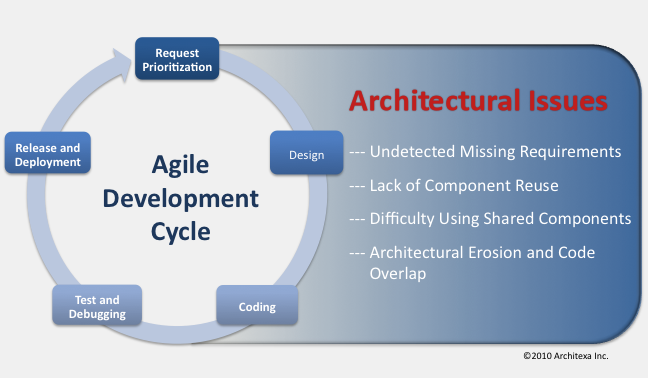Architectural Challenges for Agile Projects
The difficulty in working with Agile projects is their constantly changing code. While UML tools try to provide architectural support, they are limited as their use requires a significant amount of time before the teams can see any benefits.
With changing code, developers often cannot afford to spend months updating diagrams. Out-of-date UML diagrams prevent developers from enjoying its benefits.
Rapid code modifications in Agile projects prevent teams from benefitting from a well-defined architecture and clear module boundaries resulting in a number of problems.
Undetected missing requirements
Without a commonly understood set of components for a project shared among the team, developers are prevented from thoroughly examining architectural issues. The lack of a well-defined structure for the project prevents developers from noticing important missing capabilities during early development. Discovery of such missing requirements towards the end of the project requires significant time for both redesigning and implementing the needed capabilities.
Lack of component reuse
Component reuse is widely known to be useful in reducing bugs, improving productivity, and simplifying maintenance. However, the lack of a shared diagrams, prevent developers from getting a complete view of the architecture of the codebase, and limits the effectiveness of planning for components reuse.
Difficulty using shared components
Even with components planned and designed for reuse, unclear module boundaries result in developers not understanding the means for such usage. Both module builders and users have no guidance as to the appropriate dependencies and usage protocol - capabilities might be accidentally hidden and/or important dependencies might not be available to those needing to use the module.
Architectural erosion and code overlap
When multiple teams work on different parts of a code base and do not have an updated view of module boundaries they find it hard to determine the correct location for newly implemented features. Code often ends up in incorrect locations, resulting in structural erosion and code overlap across different modules.
Managing the challenges with Architexa
The Architexa suite has been designed to support developers in making architectural decisions and allow them to benefit from UML diagrams.
Understanding code architecture and preventing boundaries erosion
Diagrams built straight from the code allow developers to be connected to the code, and high-level overview diagrams like Layered Diagrams show developers major code modules for them to dive into. Developers can easily determine where newly implemented features should be placed and prevent architectural erosion.
Maintaining well-defined architecture and module boundaries
Architexa allows developers to easily get high-level overviews, see definitions of core code components, and examine the logic flow of important use-cases. Developers can go into the code step-by-step using the module dependencies, definitions, and capabilities, to identify similar components and ensure that the architecture is kept up-to-date with the code.
Having a consistent architecture shared with the entire team
Beyond support for discovering the architecture, Architexa allows developers to share these architecture via diagrams with added notes and comments. These diagrams act as a common reference point for a team and allow for developers to access them when needed.


